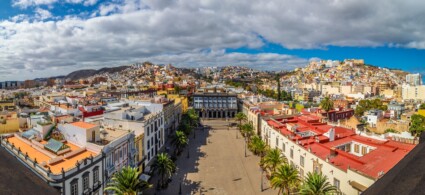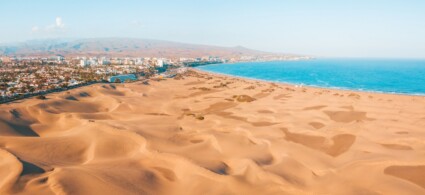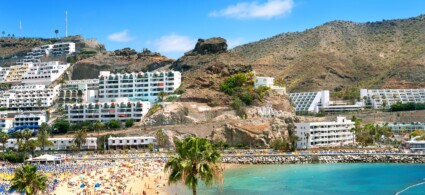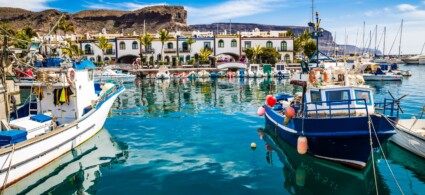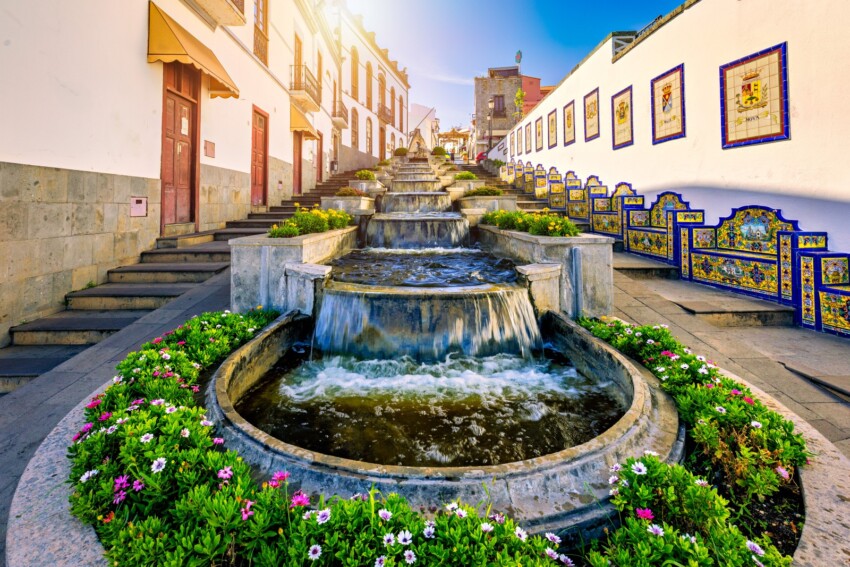

With an incredible variety of landscapes and microclimates that make it unique, Gran Canaria, the third largest of the Canary Islands archipelago after Tenerife and Fuerteventura, is a continent in miniature.
With 33 protected areas, the island boasts rugged coastlines with beautiful white sand beaches and charming black sand coves, a mountainous desert interior and lush forests in the north.
There are 21 major population centres in Gran Canaria, including the cosmopolitan and dynamic capital Las Palmas de Gran Canaria, founded in 1478. Tourist resorts particularly famous for their beaches and nightlife include Fataga, Playa del Ingles, Maspalomas, Puerto de Mogan, Bahia Feliz and Playa Puerto Rico.
The town of Aguimes in the east of the island and the town of Galdar along the north-western coast of Gran Canaria boast exceptional historical centres.
Gran Canaria offers excellent options for lovers of the sea and water sports as well as for those who enjoy hiking and horse trekking.
The island is easily accessible by direct flights thanks to Gran Canaria Airport.
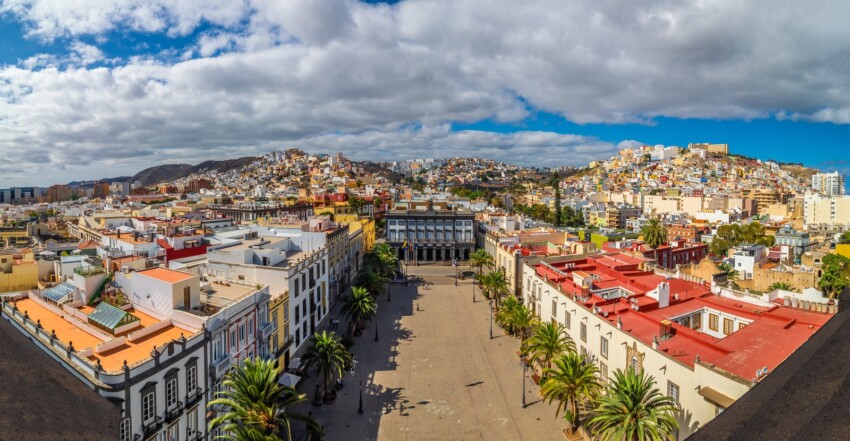
Las Palmas de Gran Canaria is a city with an exceptional historical heritage and has been declared a UNESCO World Heritage Site. The capital was founded in 1478 by the Aragonese captain Juan Rejon and is located on the north-eastern tip of the island, close to beautiful beaches.
With a strong character, the city is a mix of colonial and Andalusian-style buildings characterised by interior courtyards, pedestrian plazas, wooden balconies and cobbled streets. Piazza Santa Ana, the Cathedral of St Ana, the Hermitage of St Antonio, the Bishop’s Palace and the Royal House form the heart of the historical quarter of Vegueta.
A must-see is the Casa Museo de Columbus, the former palace of the island’s governors used by Christopher Columbus during his stay in the Canary Islands and which houses a museum full of maps, models and fragments of the navigator’s diaries, and the Museo Canario.
For a wonderful view of the city, head to the Altavista neighbourhood and for a taste of the archipelago’s excellent cuisine, choose the Santa Catalin neighbourhood, the hub of summer events. The seaside district of Isleta contains the Hermitage of Light and the Castle of Light.
Las Palmas de Gran Canaria is also home to the beautiful Canteras beach, a 3-kilometre stretch of golden sand that is much loved by the locals. Right in the centre next to the sports pier is the Playa de Las Alcaravaneras, while on the way out of the city, heading south, is the black sand beach of Playa de La Laja.
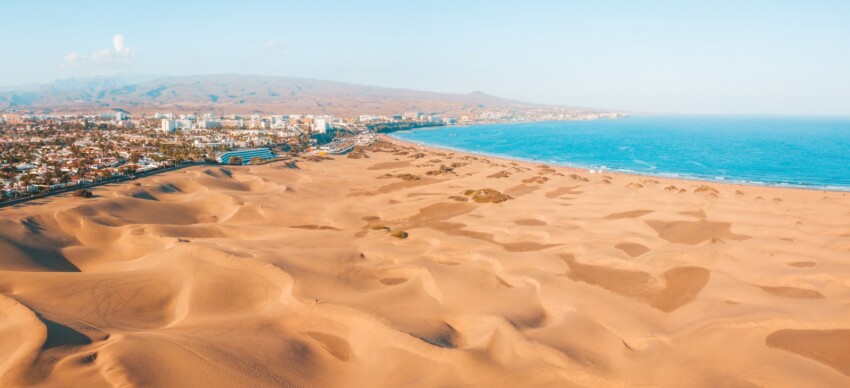
World-famous for its dunes, Maspalomas beach is located on the southern tip of Gran Canaria near the popular beach resorts of Aguilla, Las Burras, San Agustin and Playa del Ingles.
The expanse of golden sand and the 400-hectare Maspalomas Dunes Nature Reserve are bathed by shallow crystal-clear waters, making it ideal for family holidays and children.
The exclusive resort of Maspalomas boasts luxury hotels, including the superlative Lopesan Baobab Resort, exclusive residences, such as the Ifa Faro hotel, and the largest golf course on the island.
Entertainment is another highlight of the area, both in terms of nightlife and amusement parks such as Aqualand, the largest water park in Gran Canaria, Holiday World, Palmitos, an ornithological park with an aquarium, Sioux City, a Wild West theme park and the fascinating Mundo Aborigen.
The sand dunes of Maspalomas are a favourite shoreline for naturists and gays. The nudist zone starts at kiosk number 5 and extends to Playa del Ingles, while surfers meet at the curve that joins Maspalomas with Playa del Ingles.
Not to be missed is La Charca de Maspalomas, a natural lagoon separated from the sea by a small sandy strip, and the Maspalomas Lighthouse, built in 1886, which, at 65 metres high, dominates the coast and the busy promenade area where restaurants and shops can be found.
Maspalomas is about an hour’s drive from the island’s capital Las Palmas and 25 minutes from Gran Canaria Airport.
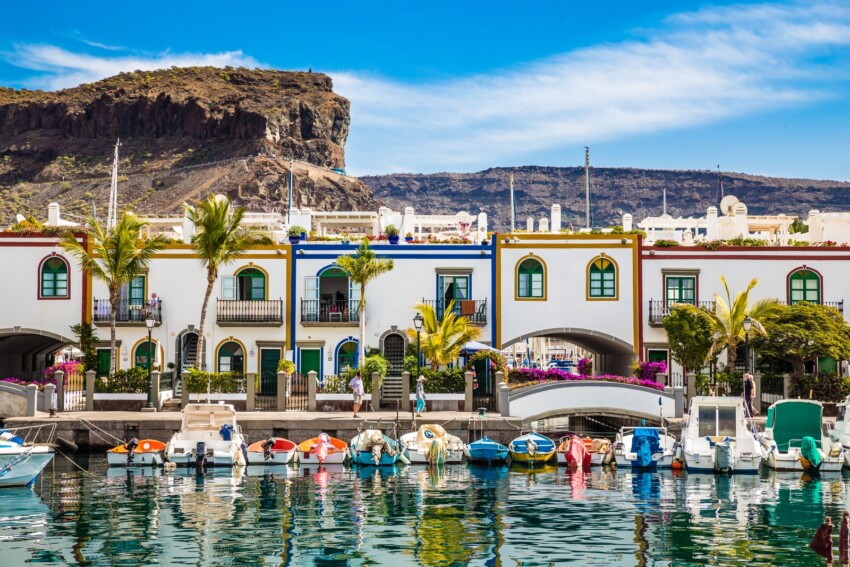
The charming town of Puerto de Mogan is located along the south-western coast of Gran Canaria, not far from the popular resorts of Playa del Ingles and Maspalomas.
This fishing port surrounded by barren cliffs has grown in recent years thanks to responsible tourism that has propelled it into the medium-high tourist bracket.
The town also owes its charm to the network of pretty seawater canals that criss-cross its historic centre, dotted with picturesque little bridges, so much so that over the years it has earned it the nickname the Venice of the Canaries.
Trendy cafés, small restaurants, live music venues and a beautiful seaside promenade make the picturesque Playa de Mogan the perfect location for those looking for a quiet, fun and even a little romantic holiday.
To the east of the harbour is a small sandy beach well protected from currents by cliffs, ideal for families with children, while just a 5-minute drive away is the charming Playa Taurito and 7 kilometres away is Playa de Amedores. The beaches of Playa de Patalavaca, Playa de la Verga, Playa del Cura, Playa de Los Frailes, Playa de Medio Almud and Playa de Tiritaña are also very beautiful.
Small boats set sail from the harbour for whale watching excursions and to Playa Puerto Rico and Arguineguin. Hiking enthusiasts will appreciate the Barranco de Veneguera gorge, which starts at the foot of the Los Azulejos rock formation, and the Ojeda Natural Park.
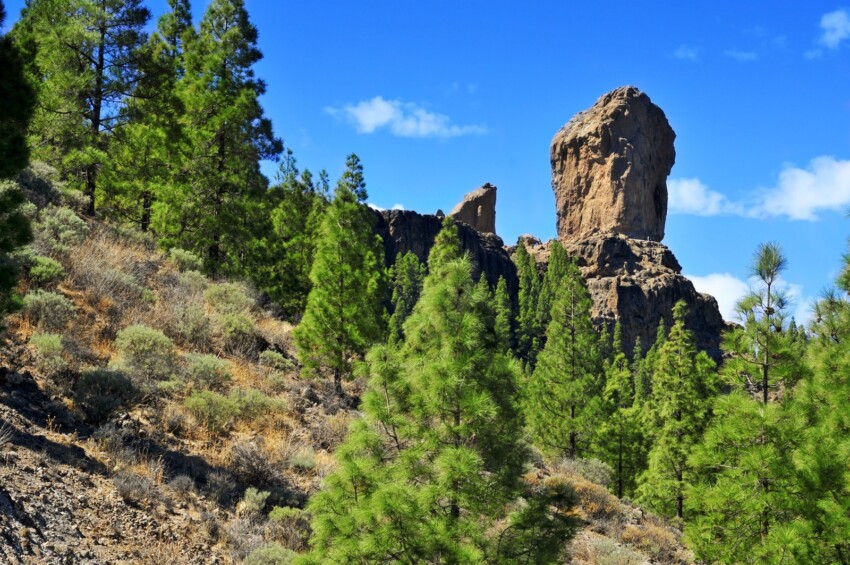
The Roque Nublo is a natural symbol of Gran Canaria that one must visit, with a walk of about half an hour offering the opportunity to explore the panorama of the central and western part of the island.
Gran Canaria was declared a UNESCO Biosphere Reserve in 2005, and the unique scenery that can be seen along this route has been named ‘The Petrified Storm‘, in reference to its spectacular pointed rocks. The hiking route leading to Roque Nublo begins in the locality of El Garañón and crosses the border of the Caldera de Tejeda, the result of numerous volcanic eruptions.
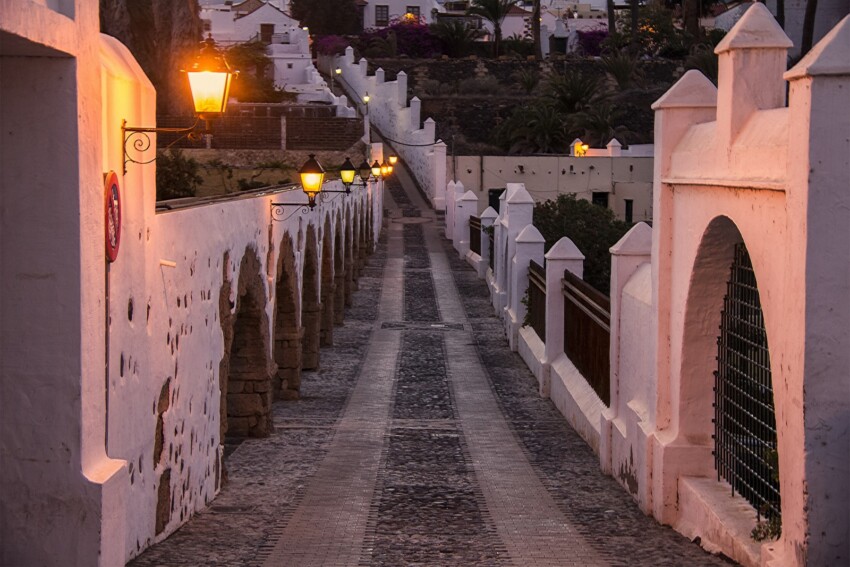
The city of Telde, the second largest on the island, is located along the east coast of Gran Canaria, south of Las Palmas de Gran Canaria, in the area known as the Great Plain.
Halfway between the tourist areas in the south of the island and the capital, Maspalomas in primis, the city centre contains historical buildings, such as the San Juan area where the church of San Pedro Mártir and the basilica of San Juan Bautista are located, while its surroundings are home to the most important pre-Hispanic archaeological sites in Gran Canaria such as el Baladero, Tufia, Cuatro Puertas, Tara and Cendro.
A visit to San Francisco, a neighbourhood full of charm thanks to the narrow, winding streets that criss-cross it and the low, whitewashed houses that line them, is a must.
Several beautiful beaches line Telde’s 10-kilometre stretch of coastline. Among the most popular are Melenara, Playa las Salinetas, San Borondon beach and Playa del Hombre, while smaller secluded ones include Playa de la Grita, Ojos de Garza beach, Tufia and Aguadulce.
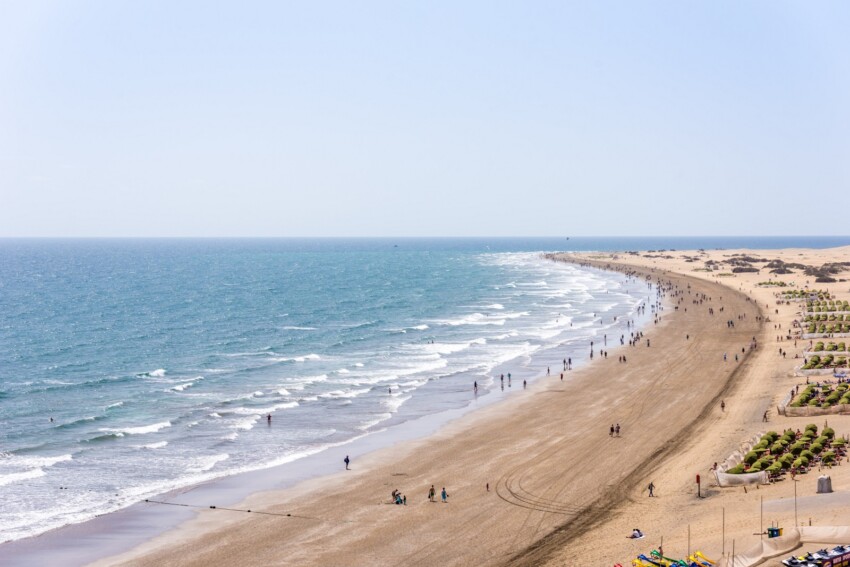
The modern and lively resort of Playa del Ingles is located along the southern coast of Gran Canaria, not far from Maspalomas, along the GC 1 motorway that connects Gran Canaria airport with the important tourist area in the south of the island.
The beautiful beach of Playa del Ingles and a wide choice of pubs, 4- and 5-star hotels, restaurants, cafés, shopping centres, discos and nightclubs have made Playa del Ingles grow to become a popular tourist centre throughout Europe. For your shopping, head to the Yumbo Centrum in Avenida de Espana or the Kasbah in Plaza del Teide.
The Paseo Costa Canaria, lined with lush tropical flora and luxury villas, is a beautiful pedestrian promenade stretching along the beach connecting Playa de las Burras to the Maspalomas dunes where you can relax after a day at the beach.
Playa del Ingles is the ideal destination for couples and groups of friends looking for a lively nightlife and beautiful beaches. Golf lovers will appreciate the nearby Maspalomas Golf Club.
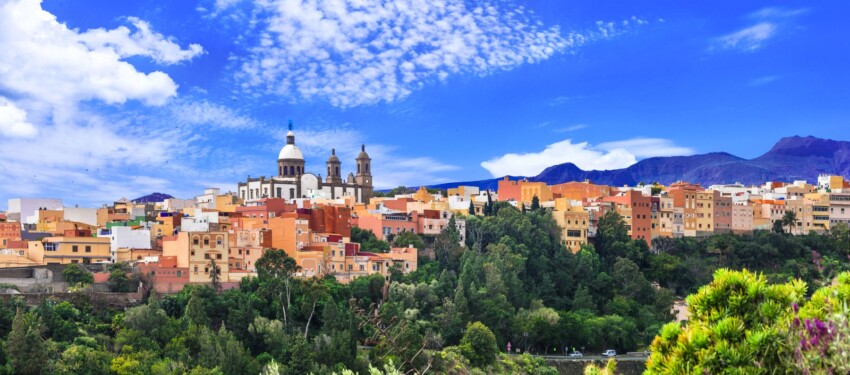
The small town of Agüimes is located in the south-eastern part of Gran Canaria, 5 kilometres from the coast and 26 kilometres from Las Palmas de Gran Canaria, and is an ideal place for hiking enthusiasts.
Its picturesque historical centre, dominated by the two towers of the church of San Sebastian, an 18th century stone building located in Plaza del Rosario, is among the best examples of traditional Canarian architecture. Ochre-coloured houses line the small, characteristic medieval streets
Not far from Aguimes are the archaeological site of Morro del Cuervo, where at least six examples of rock art can be admired, and the Guayadeque ravine, one of the largest canyons in the Canary Islands archipelago, the primitive village of Cueva Bermeja and the Cocodrilo Park, a small and very interesting zoological park.
A few kilometres away are the beautiful beaches of Playa de Vargas, ideal for windsurfing, Playa del Cabron, a mecca for diving enthusiasts, Playa de Arinaga and Playa de Balos.
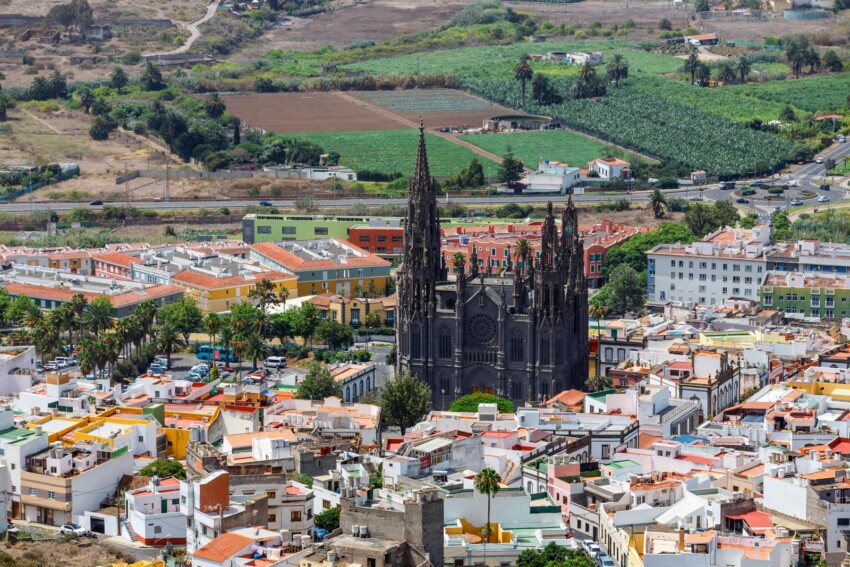
Nine kilometres west of Las Palmas de Gran Canaria, separated only by the Barranco de Tenoya gorge, is the town of Arucas, also known as the city of rum as it is home to the largest distillery in the Canary Islands, Destilerías Arehucas.
The town is dominated by the majestic neo-Gothic style church of San Juan Bautista. Also mistakenly called the Cathedral of Arucas, this majestic lava stone church boasts a 60-metre tower, the tallest in the Canary Islands. In Plaza de la Constitución, there are two other buildings of great rchitectural value: the Old Town Hall and the Market Hall, as well as other interesting buildings from the end of the 19th century, including the beautiful neoclassical building of the Heredad de Aguas de Firgas y Arucas. Another notable building is the Casa Gourié, from the early 19th century, which now houses the Municipal Museum of Arucas. Very cosy is the Jardin de Hesperides where you can escape the hustle and bustle of the city by immersing yourself in tropical plants.
The sand and pebble beaches of El Puertillo, Banaderos and San Andres are easily accessible from Arucas.
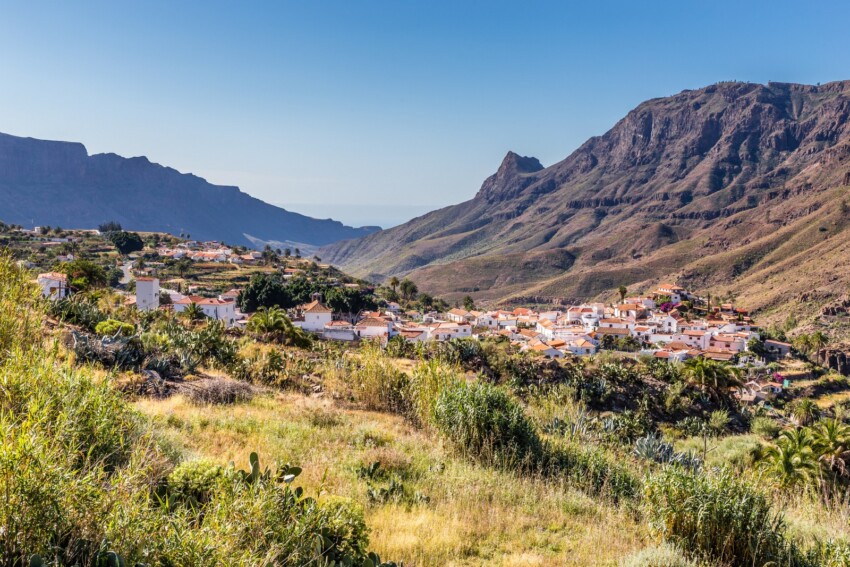
The small, traditional village of Fataga, considered the most beautiful village on the island of Gran Canaria, is located within the so-called Valley of a Thousand Palms, a picturesque area full of high cliffs, fruit trees and, of course, palm trees, 30 minutes north of Playa del Ingles.
Perched on a small promontory 600 metres above sea level, the village of Fataga, made up of quaint rural houses and delightful little shops selling local handicrafts that overlook winding cobbled streets, is the ideal place to savour tasty Canarian cuisine.
Not far away are two reservoirs, Chira and Las Ninas, surrounded by beautiful surroundings, and the Barranco de Fataga where you can take a camel ride.
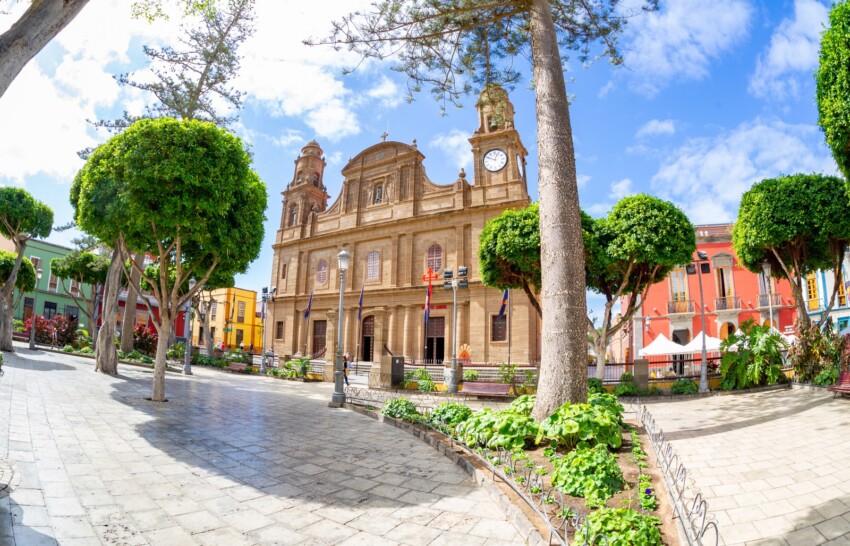
The town of Galdar is located along the north-western coast of Gran Canaria, at the foot of the Pico volcano, and is easily accessible thanks to the GC 2 motorway that connects it to the island’s capital Las Palmas de Gran Canaria.
Rich in archaeological sites and a rich architectural heritage, Galdar was the first capital of the island. The centrepiece of the town is Plaza de Santiago, overlooked by the neoclassical Iglesia de Santiago de los Caballeros, the Ayuntamiento and a former royal court.
Galdar’s main attraction is the Cueva Pintada Museum and Archaeological Park but also not to be missed is the Tumulo de la Guancha, a 12th century cemetery built from huge volcanic stones.
Sea lovers will appreciate the nearby Sardina del Norte, the beaches of los Dos Roques, and El Agujero beach, while hikers will be fascinated by the Caldeta de Los Pinos, a huge volcanic crater that offers splendid views of the entire northern coastline.
The centre of Galdar has a multitude of handicraft activities where you can buy textiles, foodstuffs, Canarian knives and terracotta and ceramic items.

You cannot leave Gran Canaria without first visiting Firgas, a small town famous for the production of mineral water, which flows from a spring at Barranco de las Madres, about 4 km away. This pretty town, which celebrated its 500th anniversary in 1988, is the ideal place if you want to visit a quiet, traditional and friendly village.
A visit to the Casa de la Cultura in Firgas is worthwhile; also in a nearby square are both the Town Hall and the church of San Roque, where young and old meet at all times of the day.
In the following map you can see the location of the main places of interest mentioned in this article.
